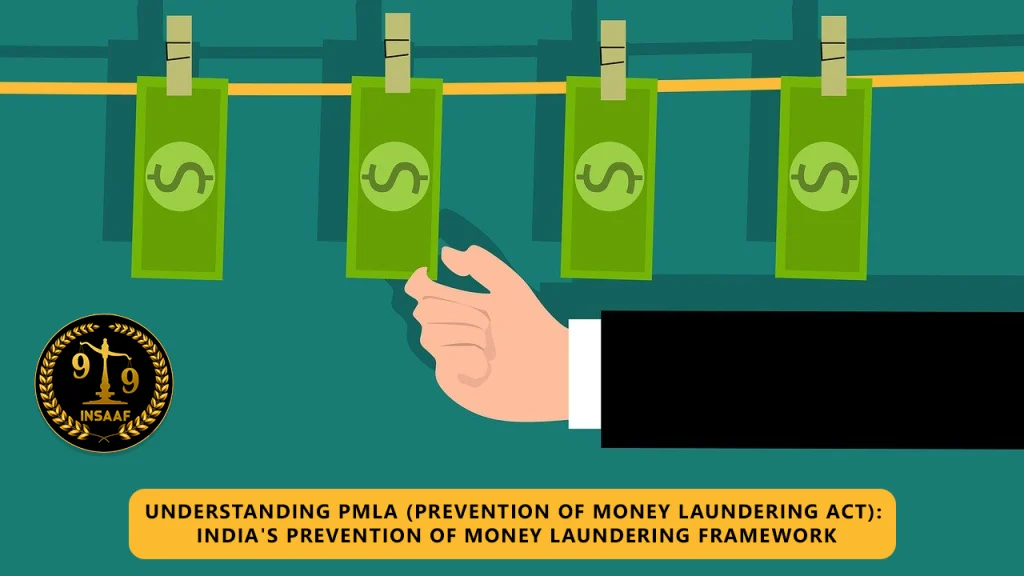

Online Legal Advice from Insaaf99® Online Lawyer Consultation in India


Online Legal Advice from Insaaf99® Online Lawyer Consultation in India

Money laundering has become a major concern all over the globe. People find various different ways to hide the origin of money obtained through illegal ways. The Prevention of Money Laundering Act, 2002 (PMLA) was brought into effect for the purpose of tacking the crime of legalizing the income/profits gained from an illegal source. It is a critical piece of legislation aimed at combating this financial crime. It allows the Government of India or its competent authority to confiscate the property earned from the illegal income. In this article we will take a look at the money laundering, PMLA and its various provisions to fight against money laundering.
Also Read: - Gifting Property: Finding What are the Legal Ways to Transfer your Property to Your Loved Ones?
It is a process through which illegal money, such as black money is disguised as legal money to eventually be portrayed as white money. In order to launder black money into white money it gets through various channels or phases of conversions before becoming a legally acceptable institution, like a bank. Usually it is done in three phases
Placement: In this phase, the large amount of black money is converted into a small portion of cash before being introduced to the financial system.
Layering: In this phase the act of disguising the origin begins as the money goes through various complex transactions. Like investment in shell companies, investment in tax haven countries, offshore accounts etc.
Integration: In this phase the black money gets drafted back into the financial system as a white money. This could be done through real estate purchases, or luxury goods.
Money laundering is done to disguise the sources, changing the form, or moving the funds to a place where they are less likely to attract attention
Financial Intelligence Unit - India (FIU-IND) describe money laundering offense as
A person shall be guilty of offense of money-laundering if such person is found to have directly or indirectly attempted to indulge or knowingly assisted or knowingly is a party or is actually involved in one or more of the following processes or activities connected with proceeds of crime, namely:
(a) concealment; or (b) possession; or (c) acquisition; or (d) use; or (e) projecting as untainted property; or (f) claiming as untainted property, in any manner whatsoever;
The process or activity connected with proceeds of crime is a continuing activity and continues till such time a person is directly or indirectly enjoying the proceeds of crime by its concealment or possession or acquisition or use or projecting it as untainted property or claiming it as untainted property in any manner whatsoever.
The PMLA Act, 2002, was introduced to combat the issue of money laundering and it serves as a primary weapon against money laundering. Some of its objectives are as follows:

Offenses: The PMLA act defines various money laundering offenses and activities connected with proceeds of crime: Concealment, Possession, Acquisition, Use, Claiming or Projecting as untainted property etc.
Reporting Requirements: The Financial Intelligence Unit in India monitors suspicious transactions, and any individual or business entity dealing in a large amount that exceeds the predefined threshold becomes obligated to report it to FIU.
Enforcement Agencies: Under PMLA, the Department of Revenue has given power to various agencies to investigate, arrest and confiscate any suspicious asset that is linked with money laundering. One of the prime agencies that take swift action against money laundering is the Enforcement Directorate.
Adjudicating Authority: The Act establishes an Adjudicating Authority to adjudicate cases of attachment and confiscation of properties.
As per FIU the proceeds of crime means any property derived or obtained, directly or indirectly, by any person as a result of criminal activity relating to a scheduled offense or the value of any such property or where such property is taken or held outside the country, then the property equivalent in value held within the country or abroad.
The offenses specified under Part A of the Schedule; or
The offenses specified under Part B of the Schedule if the total value involved in such offenses is one crore rupees or more; or
The offenses specified under Part C of the Schedule
Conclusion: The PMLA act has come as a powerful weapon against money laundering offenses. By providing power to investigating agencies like ED it has opened the way of swift action. The Act has led to a significant rise in suspicious transaction reporting filed by reporting entities, making it easier to identify potential money laundering activities. The act helps safeguard India's financial system and promotes economic stability.
Also Read: - Demystifying Family Law: A Holistic Exploration of Family Law and Its Indian Context